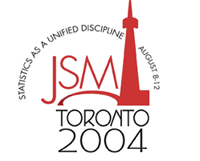|
Activity Number:
|
49
|
|
Type:
|
Contributed
|
|
Date/Time:
|
Sunday, August 8, 2004 : 4:00 PM to 5:50 PM
|
|
Sponsor:
|
Section on Quality and Productivity
|
| Abstract - #301274 |
|
Title:
|
Bayesian Modeling of Accelerated Life Tests with Random Effects
|
|
Author(s):
|
Ramon V. Leon*+ and Avery Ashby and Jayanth Thyagarajan
|
|
Companies:
|
University of Tennessee and University of Tennessee and University of Tennessee
|
|
Address:
|
331 Stokely Management Center, Knoxville, TN, 37996-0532,
|
|
Keywords:
|
MCMC ; WinBUGS ; credibility interval ; prediction interval ; quantile
|
|
Abstract:
|
We show how to use Bayesian modeling to analyze data from an accelerated life test where the test units come from different groups (such as batches) and the group effect is random and significant. Our approach can handle multiple random effects and several accelerating factors. However, we present our approach on the basis on an important application concerning pressure vessels wrapped in Kevlar 49 fibers where the fibers of each vessel comes from a single spool and the spool effect is random. We show how Bayesian modeling using Markov chain Monte Carlo methods can be used to easily answer questions of interest in accelerated life tests with random effects that are not easily answered with more traditional methods. For example, we can predict the lifetime of a pressure vessel wound with a Kevlar 49 fiber either from a spool used in the accelerated life test or from another random spool from the population of spools. We comment on the implications that this analysis has on the estimates of reliability (and safety) for the Space Shuttle, which has a system of 22 such pressure vessels.
|
